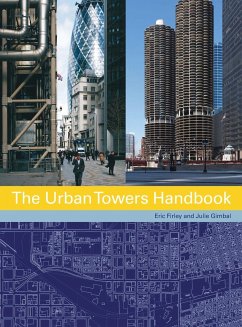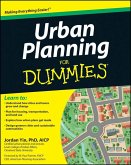- Gebundenes Buch
- Merkliste
- Auf die Merkliste
- Bewerten Bewerten
- Teilen
- Produkt teilen
- Produkterinnerung
- Produkterinnerung
The Urban Towers Handbook includes 30 in-depth case studies of iconic towers from around the world, organized according to type. These range from historic examples, such as the Eiffel Tower in Paris, the Chrysler Building in New York, and the medieval tower houses of San Gimignano in Tuscany, to highly contemporary examples, such as the Burj Al Arab in Dubai and the Roppogni Hills in Tokyo. In addition, each case study features one or two further examples of contemporary projects that share a similar urban configuration.
Andere Kunden interessierten sich auch für
![The Urban Masterplanning Handbook The Urban Masterplanning Handbook]() Eric FirleyThe Urban Masterplanning Handbook76,99 €
Eric FirleyThe Urban Masterplanning Handbook76,99 €![The Evolution of American Urban Design The Evolution of American Urban Design]() David GoslingThe Evolution of American Urban Design90,99 €
David GoslingThe Evolution of American Urban Design90,99 €![Urban Planning for Dummies Urban Planning for Dummies]() Jordan YinUrban Planning for Dummies25,99 €
Jordan YinUrban Planning for Dummies25,99 €![Urban Design Ecologies Urban Design Ecologies]() Urban Design Ecologies48,99 €
Urban Design Ecologies48,99 €![The Sustainable Sites Handbook The Sustainable Sites Handbook]() Meg CalkinsThe Sustainable Sites Handbook125,99 €
Meg CalkinsThe Sustainable Sites Handbook125,99 €![Urban Design for an Urban Century Urban Design for an Urban Century]() Lance Jay BrownUrban Design for an Urban Century105,99 €
Lance Jay BrownUrban Design for an Urban Century105,99 €![Sustainable Urbanism Sustainable Urbanism]() Douglas FarrSustainable Urbanism98,99 €
Douglas FarrSustainable Urbanism98,99 €-
-
-
The Urban Towers Handbook includes 30 in-depth case studies of iconic towers from around the world, organized according to type. These range from historic examples, such as the Eiffel Tower in Paris, the Chrysler Building in New York, and the medieval tower houses of San Gimignano in Tuscany, to highly contemporary examples, such as the Burj Al Arab in Dubai and the Roppogni Hills in Tokyo. In addition, each case study features one or two further examples of contemporary projects that share a similar urban configuration.
Hinweis: Dieser Artikel kann nur an eine deutsche Lieferadresse ausgeliefert werden.
Hinweis: Dieser Artikel kann nur an eine deutsche Lieferadresse ausgeliefert werden.
Produktdetails
- Produktdetails
- Verlag: Wiley & Sons
- 1. Auflage
- Seitenzahl: 272
- Erscheinungstermin: 20. Juni 2011
- Englisch
- Abmessung: 286mm x 221mm x 19mm
- Gewicht: 1390g
- ISBN-13: 9780470684740
- ISBN-10: 0470684747
- Artikelnr.: 32560381
- Herstellerkennzeichnung
- Libri GmbH
- Europaallee 1
- 36244 Bad Hersfeld
- gpsr@libri.de
- Verlag: Wiley & Sons
- 1. Auflage
- Seitenzahl: 272
- Erscheinungstermin: 20. Juni 2011
- Englisch
- Abmessung: 286mm x 221mm x 19mm
- Gewicht: 1390g
- ISBN-13: 9780470684740
- ISBN-10: 0470684747
- Artikelnr.: 32560381
- Herstellerkennzeichnung
- Libri GmbH
- Europaallee 1
- 36244 Bad Hersfeld
- gpsr@libri.de
Eric Firley is a French-German architect and urban designer. The author of The Urban Housing Handbook (John Wiley & Sons Ltd, 2009), he is Assistant Professor at the University of Miami School of Architecture and heads an international research consultancy. Julie Gimbal is a French art historian with a special interest in high-rise architecture. She holds a doctorate from the University of Rennes on the subject of high-rise architecture in France and is responsible for the second section of the book on high-rise regulations. She also helped to inform the choice of case studies in the first part of the book. Philippe Honnorat, a French Engineer, heads the Paris office of WSP Flack + Kurtz. An expert in Mechanical and Electrical systems, he has worked in the UK and USA, and has extensive international experience in high-rise structures. Honnorat wrote the third section of the book covering sustainability issues.
Preface
Acknowledgements
Introduction
Section A: A visual dictionary of high-rise buildings
1st Group: Solitaires and Twin Towers
1 - Monument
Main example: Kingdom Centre, Riyadh
Secondary 1: Moscow State University
Secondary 2: Burj Khalifa, Dubai
2 - Monument in block
Main example: 30 St Mary Axe, London
Secondary 1: Torre Agbar, Barcelona
Secondary 2: Seagram Building, New York City
3 - Tower as block
Main example: Commerzbank Tower, Frankfurt
Secondary 1: Transamerica Pyramid, San Francisco
Seconday 2: Hotel Ukraina, Moscow
4 - Tower in block
Main example: Torre Velasca, Milan
Secondary 1: Kudamm-Karree, Berlin
Secondary 2: Norddeutsche Landesbank, Hanover
5 - Twin towers
Main example: Kungstornen, Stockholm
Secondary 1: Marina City Towers, Chicago
Secondary 2: Puerta de Europa, Madrid
6 - Tower as team player
Main example: Tokyo Metropolitan Government Building
Secondary 1: Thyssen-Haus, Düsseldorf
Secondary 2: United Nations Headquarters, New York City
7 - Tower on infrastructure
Main example: The Standard Hotel, New York City
Secondary 1: Shard London Bridge, London
Secondary 2: Tour Dexia (CBX), La Défense
8 - Tower as module / business as usual
Main example: Tour Ar Men, Paris
Secondary 1: DUOC Corporate Building, Santiago de Chile
Secondary 2: Banco Atlántico, Barcelona
2nd Group: Clusters
1 - Integrated in existing city fabric
Main example: Rockefeller Center, New York City
Secondary 1: Villeurbanne Town Hall and new centre
Secondary 2: Riverside Center, New York City
2 - Towers as urban pattern
Main example: Quartier du Palais ('Immeubles Choux'), Créteil
Secondary 1: Jianwai SOHO, Beijing
Secondary 2: Stuyvesant Town, New York City
3 - Linear cluster
Main example: Sheikh Zayed Road, Dubai
Secondary 1: Playa de Levante extension, Benidorm
Secondary 2: Rue de la Loi masterplan, Brussels
4 - High-rise compound
Main example: Moma and Pop Moma, Beijing
Secondary 1: Marina Baie des Anges, Villeneuve-Loubet
Secondary 2: Icon Brickell, Miami
5 - High-rise megastructure
Main example: Roppongi Hills Mori Tower, Tokyo
Secondary 1: Parque Central, Caracas
Secondary 2: Pinnacle@Duxton, Singapore
6 - Towers in nature
Main example: Hansaviertel, Berlin
Secondary 1: Unité d'Habitation, Marseille
Secondary 2: Newton Suites, Singapore
7 - Towers on podium
Main example: Front de Seine, Paris
Secondary 1: Jumeirah Beach Residences, Dubai
Secondary 2: Tour 9, Montreuil
3rd Group: Vertical Cities
1 - US-American downtown:
Main example: Downtown Houston
2 - High-rise as norm:
Main example: Higienópolis, São Paulo
3 - High-rise as geographical obligation:
Main example: Monaco
4 - City of monuments:
Main example: Lujiazui, Shanghai
5 - European CBD:
Main example: La Défense
Secondary: La Défense extension (Tour AIR2)
6 - City of megastructures:
Main example: Hong Kong
Section B: High-rise building regulations in seven cities worldwide
London
Frankfurt
Vienna
Paris
New York
Hong Kong
Singapore
Section C: High-rise and sustainability
Comparative table
Bibliography
Index
Picture credits
Acknowledgements
Introduction
Section A: A visual dictionary of high-rise buildings
1st Group: Solitaires and Twin Towers
1 - Monument
Main example: Kingdom Centre, Riyadh
Secondary 1: Moscow State University
Secondary 2: Burj Khalifa, Dubai
2 - Monument in block
Main example: 30 St Mary Axe, London
Secondary 1: Torre Agbar, Barcelona
Secondary 2: Seagram Building, New York City
3 - Tower as block
Main example: Commerzbank Tower, Frankfurt
Secondary 1: Transamerica Pyramid, San Francisco
Seconday 2: Hotel Ukraina, Moscow
4 - Tower in block
Main example: Torre Velasca, Milan
Secondary 1: Kudamm-Karree, Berlin
Secondary 2: Norddeutsche Landesbank, Hanover
5 - Twin towers
Main example: Kungstornen, Stockholm
Secondary 1: Marina City Towers, Chicago
Secondary 2: Puerta de Europa, Madrid
6 - Tower as team player
Main example: Tokyo Metropolitan Government Building
Secondary 1: Thyssen-Haus, Düsseldorf
Secondary 2: United Nations Headquarters, New York City
7 - Tower on infrastructure
Main example: The Standard Hotel, New York City
Secondary 1: Shard London Bridge, London
Secondary 2: Tour Dexia (CBX), La Défense
8 - Tower as module / business as usual
Main example: Tour Ar Men, Paris
Secondary 1: DUOC Corporate Building, Santiago de Chile
Secondary 2: Banco Atlántico, Barcelona
2nd Group: Clusters
1 - Integrated in existing city fabric
Main example: Rockefeller Center, New York City
Secondary 1: Villeurbanne Town Hall and new centre
Secondary 2: Riverside Center, New York City
2 - Towers as urban pattern
Main example: Quartier du Palais ('Immeubles Choux'), Créteil
Secondary 1: Jianwai SOHO, Beijing
Secondary 2: Stuyvesant Town, New York City
3 - Linear cluster
Main example: Sheikh Zayed Road, Dubai
Secondary 1: Playa de Levante extension, Benidorm
Secondary 2: Rue de la Loi masterplan, Brussels
4 - High-rise compound
Main example: Moma and Pop Moma, Beijing
Secondary 1: Marina Baie des Anges, Villeneuve-Loubet
Secondary 2: Icon Brickell, Miami
5 - High-rise megastructure
Main example: Roppongi Hills Mori Tower, Tokyo
Secondary 1: Parque Central, Caracas
Secondary 2: Pinnacle@Duxton, Singapore
6 - Towers in nature
Main example: Hansaviertel, Berlin
Secondary 1: Unité d'Habitation, Marseille
Secondary 2: Newton Suites, Singapore
7 - Towers on podium
Main example: Front de Seine, Paris
Secondary 1: Jumeirah Beach Residences, Dubai
Secondary 2: Tour 9, Montreuil
3rd Group: Vertical Cities
1 - US-American downtown:
Main example: Downtown Houston
2 - High-rise as norm:
Main example: Higienópolis, São Paulo
3 - High-rise as geographical obligation:
Main example: Monaco
4 - City of monuments:
Main example: Lujiazui, Shanghai
5 - European CBD:
Main example: La Défense
Secondary: La Défense extension (Tour AIR2)
6 - City of megastructures:
Main example: Hong Kong
Section B: High-rise building regulations in seven cities worldwide
London
Frankfurt
Vienna
Paris
New York
Hong Kong
Singapore
Section C: High-rise and sustainability
Comparative table
Bibliography
Index
Picture credits
Preface
Acknowledgements
Introduction
Section A: A visual dictionary of high-rise buildings
1st Group: Solitaires and Twin Towers
1 - Monument
Main example: Kingdom Centre, Riyadh
Secondary 1: Moscow State University
Secondary 2: Burj Khalifa, Dubai
2 - Monument in block
Main example: 30 St Mary Axe, London
Secondary 1: Torre Agbar, Barcelona
Secondary 2: Seagram Building, New York City
3 - Tower as block
Main example: Commerzbank Tower, Frankfurt
Secondary 1: Transamerica Pyramid, San Francisco
Seconday 2: Hotel Ukraina, Moscow
4 - Tower in block
Main example: Torre Velasca, Milan
Secondary 1: Kudamm-Karree, Berlin
Secondary 2: Norddeutsche Landesbank, Hanover
5 - Twin towers
Main example: Kungstornen, Stockholm
Secondary 1: Marina City Towers, Chicago
Secondary 2: Puerta de Europa, Madrid
6 - Tower as team player
Main example: Tokyo Metropolitan Government Building
Secondary 1: Thyssen-Haus, Düsseldorf
Secondary 2: United Nations Headquarters, New York City
7 - Tower on infrastructure
Main example: The Standard Hotel, New York City
Secondary 1: Shard London Bridge, London
Secondary 2: Tour Dexia (CBX), La Défense
8 - Tower as module / business as usual
Main example: Tour Ar Men, Paris
Secondary 1: DUOC Corporate Building, Santiago de Chile
Secondary 2: Banco Atlántico, Barcelona
2nd Group: Clusters
1 - Integrated in existing city fabric
Main example: Rockefeller Center, New York City
Secondary 1: Villeurbanne Town Hall and new centre
Secondary 2: Riverside Center, New York City
2 - Towers as urban pattern
Main example: Quartier du Palais ('Immeubles Choux'), Créteil
Secondary 1: Jianwai SOHO, Beijing
Secondary 2: Stuyvesant Town, New York City
3 - Linear cluster
Main example: Sheikh Zayed Road, Dubai
Secondary 1: Playa de Levante extension, Benidorm
Secondary 2: Rue de la Loi masterplan, Brussels
4 - High-rise compound
Main example: Moma and Pop Moma, Beijing
Secondary 1: Marina Baie des Anges, Villeneuve-Loubet
Secondary 2: Icon Brickell, Miami
5 - High-rise megastructure
Main example: Roppongi Hills Mori Tower, Tokyo
Secondary 1: Parque Central, Caracas
Secondary 2: Pinnacle@Duxton, Singapore
6 - Towers in nature
Main example: Hansaviertel, Berlin
Secondary 1: Unité d'Habitation, Marseille
Secondary 2: Newton Suites, Singapore
7 - Towers on podium
Main example: Front de Seine, Paris
Secondary 1: Jumeirah Beach Residences, Dubai
Secondary 2: Tour 9, Montreuil
3rd Group: Vertical Cities
1 - US-American downtown:
Main example: Downtown Houston
2 - High-rise as norm:
Main example: Higienópolis, São Paulo
3 - High-rise as geographical obligation:
Main example: Monaco
4 - City of monuments:
Main example: Lujiazui, Shanghai
5 - European CBD:
Main example: La Défense
Secondary: La Défense extension (Tour AIR2)
6 - City of megastructures:
Main example: Hong Kong
Section B: High-rise building regulations in seven cities worldwide
London
Frankfurt
Vienna
Paris
New York
Hong Kong
Singapore
Section C: High-rise and sustainability
Comparative table
Bibliography
Index
Picture credits
Acknowledgements
Introduction
Section A: A visual dictionary of high-rise buildings
1st Group: Solitaires and Twin Towers
1 - Monument
Main example: Kingdom Centre, Riyadh
Secondary 1: Moscow State University
Secondary 2: Burj Khalifa, Dubai
2 - Monument in block
Main example: 30 St Mary Axe, London
Secondary 1: Torre Agbar, Barcelona
Secondary 2: Seagram Building, New York City
3 - Tower as block
Main example: Commerzbank Tower, Frankfurt
Secondary 1: Transamerica Pyramid, San Francisco
Seconday 2: Hotel Ukraina, Moscow
4 - Tower in block
Main example: Torre Velasca, Milan
Secondary 1: Kudamm-Karree, Berlin
Secondary 2: Norddeutsche Landesbank, Hanover
5 - Twin towers
Main example: Kungstornen, Stockholm
Secondary 1: Marina City Towers, Chicago
Secondary 2: Puerta de Europa, Madrid
6 - Tower as team player
Main example: Tokyo Metropolitan Government Building
Secondary 1: Thyssen-Haus, Düsseldorf
Secondary 2: United Nations Headquarters, New York City
7 - Tower on infrastructure
Main example: The Standard Hotel, New York City
Secondary 1: Shard London Bridge, London
Secondary 2: Tour Dexia (CBX), La Défense
8 - Tower as module / business as usual
Main example: Tour Ar Men, Paris
Secondary 1: DUOC Corporate Building, Santiago de Chile
Secondary 2: Banco Atlántico, Barcelona
2nd Group: Clusters
1 - Integrated in existing city fabric
Main example: Rockefeller Center, New York City
Secondary 1: Villeurbanne Town Hall and new centre
Secondary 2: Riverside Center, New York City
2 - Towers as urban pattern
Main example: Quartier du Palais ('Immeubles Choux'), Créteil
Secondary 1: Jianwai SOHO, Beijing
Secondary 2: Stuyvesant Town, New York City
3 - Linear cluster
Main example: Sheikh Zayed Road, Dubai
Secondary 1: Playa de Levante extension, Benidorm
Secondary 2: Rue de la Loi masterplan, Brussels
4 - High-rise compound
Main example: Moma and Pop Moma, Beijing
Secondary 1: Marina Baie des Anges, Villeneuve-Loubet
Secondary 2: Icon Brickell, Miami
5 - High-rise megastructure
Main example: Roppongi Hills Mori Tower, Tokyo
Secondary 1: Parque Central, Caracas
Secondary 2: Pinnacle@Duxton, Singapore
6 - Towers in nature
Main example: Hansaviertel, Berlin
Secondary 1: Unité d'Habitation, Marseille
Secondary 2: Newton Suites, Singapore
7 - Towers on podium
Main example: Front de Seine, Paris
Secondary 1: Jumeirah Beach Residences, Dubai
Secondary 2: Tour 9, Montreuil
3rd Group: Vertical Cities
1 - US-American downtown:
Main example: Downtown Houston
2 - High-rise as norm:
Main example: Higienópolis, São Paulo
3 - High-rise as geographical obligation:
Main example: Monaco
4 - City of monuments:
Main example: Lujiazui, Shanghai
5 - European CBD:
Main example: La Défense
Secondary: La Défense extension (Tour AIR2)
6 - City of megastructures:
Main example: Hong Kong
Section B: High-rise building regulations in seven cities worldwide
London
Frankfurt
Vienna
Paris
New York
Hong Kong
Singapore
Section C: High-rise and sustainability
Comparative table
Bibliography
Index
Picture credits








